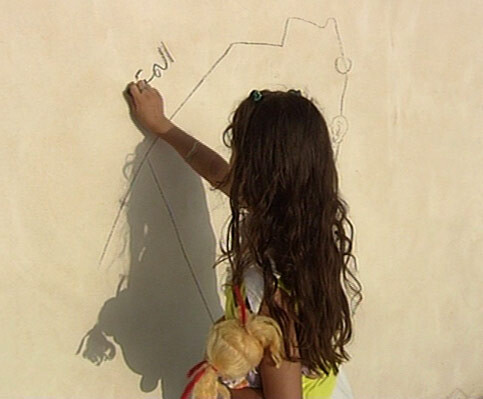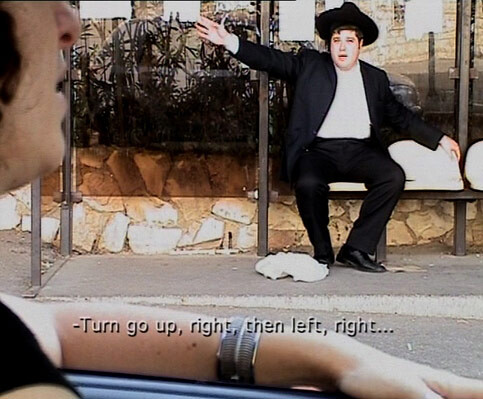The Electronic Intifada 28 March 2007

Production still from “Red, Dead and Mediterranean”
Summer 2006, Palestine — a crossover between film, video art, individual expression and a collective voice — is a unique experience in the Palestinian cultural scene. This collection of short films brings together 13 individual artists with different degrees of experience within the Palestinian film scene and other visual arts disciplines to convey the summer of 2006 in Palestine.
The project is the result of an initiative led by several Palestinian filmmakers from the Palestinian Filmmakers’ Collective. Since its inception in 2005, the collective has generated a platform for discussion and exchange amongst Palestinian filmmakers. “Summer 2006, Palestine” is their first “filmic” production.
Originally, the idea behind a short film collection was to encourage Palestinian filmmakers to create scenes that would develop into a feature length film. The idea evolved into an expression of an experience around a central theme. In August 2006 an open call was made to all Palestinian filmmakers to create a three-minute short film in one month, using one shot and expressing an experience of summer in Palestine 2006.
As such, this collection of films conveys different Palestinian experiences while exploring various technical and creative approaches to sound and imagery. Viewers are constantly asked to zoom into each film individually and then to zoom out and think of the film within the context of the others.
The collection starts with “Red, Dead and Mediterranean” by Akram Al-Ashqar and ends with “Not Just Any Sea” by Nahed Awad. This alignment in itself sets up a sort of beginning and an end. Briefly, “Red, Dead and Mediterranean” addresses the Palestinian longing for the sea as the natural border of historic Palestine, as a longing for a normal human activity in the summer which entails going to the beach. We watch a little girl sketch a somewhat distorted map of Palestine defined by the three seas: the Mediterranean from the west, Dead Sea in the east and the Red Sea in the south. Here what stands out is the child’s perception of her location. The somewhat distorted map that the child draws is then juxtaposed by her use of the map to navigate her position in relation to the Mediterranean Sea in reality. She points to the horizon, saying “There is the Mediterranean sea.” Even though we can’t really see the Mediterranean, we see an insistence in the Palestinian imagination to define their reality by it.

Production still from “Not Just Any Sea”
“Security Leak” by Rowan Al-Faqih articulates the same concept. Set within a car that is frantically driving along the corners of the Wall, the camera gives a feeling of claustrophobia and panic. The footage is raw, as the focus is jumpy and the movement of the car is fast and at times unpredictable. Viewers are disoriented; there are clear moments where we see the iconic image of the Wall, grey concrete marked by lots of graffiti. Then the shades of the Wall start changing and we are not sure if we are looking at Israeli-built Wall or neighborhood walls. As the focus shifts to the glass of the car, it becomes another wall that is blocking our view. Both the title and the disorienting visuals suspend the viewer. Are we looking for something, or running away from something? Ironically, in the end, what we find is just a small gap that is not completely blocked with concrete, allowing us to see through to the other side. Unfortunately, the film’s suspense is partly broken when the driver gets out of the car to fetch the camera from the other side. This is primarily because at that moment there is a clear break between the driver’s view and the camera’s view. As a result, the camera, and in turn the viewer, are not given the chance to slowly discover that gap amongst all the concrete. Instead we are directed to it by the driver.

Production still from “A world apart within 15 minutes”
“A world apart within 15 minutes” is also set in a car but on the other side, the Israeli side. Here the visual contrast is interesting. The ride is easy, seemingly in a straight line. We don’t have that visual paranoia or claustrophobia. Here the camera is not pointing to the road, but is set so that we can peek at the people on the side of the driver, who are unable to give her directions to Ramallah. Other than stressing this irony, the film defines this Israeli neighborhood in relation to its proximity to a Palestinian city. The Israeli area is not given a name. This adds another layer of complexity to the inability of average Israelis on the street to give our driver directions to Ramallah.
It is clear to us that the driver knows how to get to Ramallah, because she never follows any of the directions given to her. At times, she even tries to misguide them by asking them if it was an hour away, just to make a point of their ignorance. But is it really simply ignorance, or is it denial? Given that we are asked to focus on the responses of people, it is important to think of these reactions in terms of to whom and how the question is being asked. As the driver addresses them in an American accent yet pronunced “Ramallah” with an Arabic accent, we are left wondering if some people were also playing with her by deliberately giving her the wrong directions.
The film quickly brings to mind Eyal Sivan and Michael Khleifi’s Route 181; Fragments of a Journey in Palestine-Israel, a four-and-a-half-hour documentary that revisits the route of the 1947 partition plan. Some of the initial reactions of the people when interviewed were similar, but the length of the film allows us to go beyond these initial responses to see further irony and complexity whether in the form of ignorance, racism, vulnerability, hatred, or nationalism — the list goes on. In “A world apart within 15 minutes”, this is partly felt, for example, when an old Israeli woman assumes that our driver is coming to a garden party. At this moment our driver is mistaken for a local and is greeted with some warmth. As soon as she asks her for directions to Ramallah, the old woman disengages with the driver and slams the door. But this is a moment when we see that there are potentially more layers to uncover.
Nonetheless, it becomes clear that the border is not only a concrete grey wall, but a mental process of denial and obliteration. In the context of the collection, this film establishes a point of comparison between the Palestinian side that is desperately trying to find a way out, while the Israeli side can very easily and casually be both ignorant and oblivious. While Israelis are a constant reality for Palestinians, the Palestinians are something that Israelis can easily choose to erase from their imaginations.

Production still from “Football on Thursday Morning”
Similarly, “Sound of the Street” by Annmarie Jacir, draws a comparison between ants and the Palestinian street. Ants are usually a symbol of rigor and teamwork. In this film, we see individual ants casually passing one another as they head to their separate destinations. When interrupted by a barrier from one end, the ants suddenly start fighting one another. The audio — comprised of different anecdotes of women gossiping, a young man looking for a job, and others commenting on the football game between Italy and France — echoes the individual paths of the ants. At times there is more synchronization between the ants’ movement and the human voices. Primarily, the anecdotes offer an immediate comic effect, while fixing the visual symbolism in a particular meaning rooted within the Palestinian situation. Once the barrier interrupts the ants’ movement there is a different relation between the sound and imagery. The voiceover continues at the same pace and repeats the same phrases, giving us the impression that there is a gap or disconnection between the sound of the street and what is happening on the street.
Even though the two films criticize the internal division in the Palestinian street, they do so safely. Both films mirror the sentiment of the Palestinian public but they don’t necessarily challenge it. These films give a Palestinian audience comic relief, a chance to laugh at itself out loud, which is something that is needed when reality is too bitter to cope with.

Production still from “to the Arabs of Haifa a special message …”
To it’s strength, the film isolates a critical moment which was partly gone unnoticed and finds simple techniques to execute it. By simply turning the camera around the room and playing with the sound, the filmmaker successfully takes us into a hallucination of reality. The narrative of the film retains this simplicity by taking the “message” literally and responding to it. In doing so it provokes a reaction from Palestinian and Arab audiences.
The “message” is a painfully recalls the Palestinians who temporarily fled their land during the establishment of the State of Israel in 1948 and are still unable to return. It is also an uncomfortable reminder of the dilemmas of the Palestinians living within Israel. While the film doesn’t necessarily say that the Palestinians within Israel are leaving, one can either read it as a “dare” or a “plea” for a different message — a message that would call for the “Arabs of Haifa” to stay put or at least publicly acknowledge or support of their silent struggle to maintain their existence.
Most importantly the film is critical of an Arab political leader that was at the height of his popularity during summer 2006, both within Palestine and across the Arab world. The title itself is a reminder that even Hezbollah, a political party made famous by its struggle against Israel, has unconsciously slipped and adopted the Israeli political rhetoric, by referring to the Palestinians living in Haifa as “the Arabs of Haifa”.
The film ends with the three characters pondering a view of the Mediterranean Sea. Unlike the other films where the sea is a longing for a way out, here it becomes has potential for obliteration.
The significance in Summer 2006, Palestine is that it re-introduces some of the common symbolism found in Palestinian literature in a variety of interpretations, as well as introducing new symbolism. Because it is both an individual and collective expression it opens a space for comparison and discussion, all while using a contemporary medium.
Summer 2006, Palestine will be screened at the Chicago Palestine Film Festival (April 13-26) and the London Palestine Film Festival (April 27-May 10)
Shuruq Harb is an emerging Palestinian artist. Her practice is based in photography and video art. She earned a B.A. in Philosophy from Earlham College, Indiana, U.S.A and an M.A. in Photographic Studies from Westminster University, London, U.K. She currently lives and works in Ramallah.
Related Links

